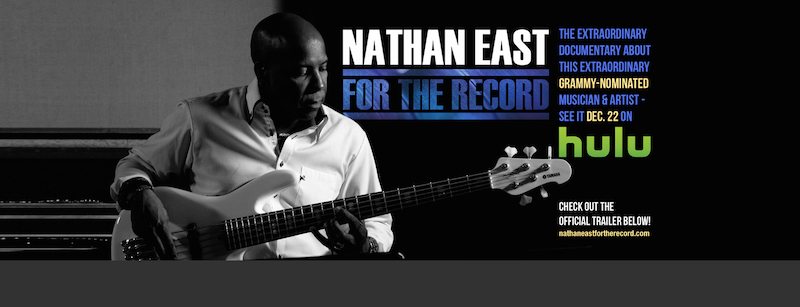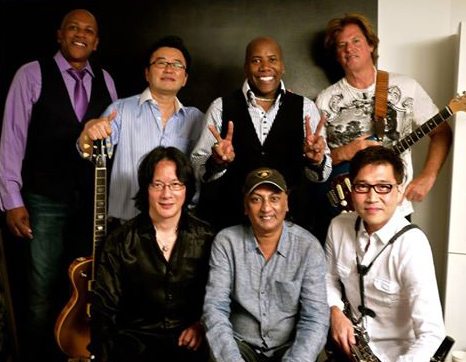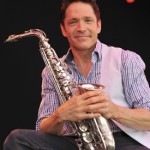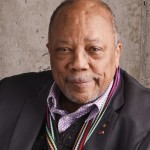About one hour into the fascinating, just-released documentary Nathan East: For The Record, there is a quick scene of the bassist sitting on a sofa, quietly perusing his old calendar books from the mid-nineties. “I love keeping these around,” he says as he scans his life-at-a-glance in the little black journals. “It’s like a time capsule and I can go back and see what I was doing.” The entire scene lasts no more than forty seconds, but it is a moment in the film that seems to perfectly capture Nathan’s life and career. As the camera gently pans across and zooms in on the open pages, we see his clean meticulous handwriting, his attention to detail. The names of music stars and legends scatter across the calendar days that are filled with sessions to make and gigs to play, reading almost like a pop music history book. The man is in demand by the very best in the business. But an even closer look also reveals his self-reminders about those who aren’t the stars, written with as much care. Mom’s operation @ Sharp Memorial, right kneeis inked in on the 4th, just above Herbie Hancock at Pyramid Studio on the 11th and Natalie Cole and George Duke at Ocean Way on the 18th. He has Mom and Dad’s anniversary on the 28th, the same day as a 9-hour Phil Collins big-band rehearsal in France, one box down from a session for the Escape From LA soundtrack. A flip of the page, more of the same. Sting, Elton, James Taylor, Don Henley. Aunt Doris and Uncle James. Birthday reminders about friends and relatives.

Perhaps one of the most telling things about this scene is that Nathan East has many people in his life, they are all important to him, and somehow he makes time for all of them. After watching the wonderfully crafted 80-minute documentary, one gets the sense that he is so well-grounded, so rooted in family, and so able to connect to others that he probably could have succeeded at anything he attempted in life. Of course, we are all the better for it that Nathan chose the bass as his calling. He has not only become one of the most recorded bassists of all time with more than 2000 record credits, but more importantly, he has graced every one of those records with his soul and spirit.
For The Record traces Nathan’s journey from his early days growing up in San Diego, picking up his first big gig at age 16 with Barry White, arriving on the bustling 80’s LA studio scene, landing even bigger gigs playing for presidents, popes and Beatles, and the creation of his jazz quartet Fourplay. The film is not your standard start-here-and-end-there music doc, but rather two separate timelines simultaneously, perfectly edited by Spencer Glover and aided by a well-thought out storyline by Sara Bachler. It seamlessly cuts back and forth between the making of Nathan East the solo album, and the making of Nathan East, the life. Throughout the whole affair, there are numerous heartfelt testimonials from many of the greats he has worked with, and they are more than happy to offer their feelings about Nathan or tell a story from their shared past. They have all shown up here to support him and his musical legacy, because he has spent his last 35 years showing up for them and supporting theirs.
When I recently caught up with Nate, it was nearly a year after I spoke with him last, just before the imminent release of his solo debut (Click to read cover interview). At that time all we really knew about his new career-to-be was that he had just recorded a brilliant album. How it was to be received by the public was the part that had not yet been written, and he had admitted to a bit of nervousness before stepping out in front of an audience to perform four tracks from his album for the first time. Looking back now of course, it seems clear that Nathan’s tale of 2014 could not have turned out any less amazing than his first 35 years in the business. In any terms you want, any scale of your choosing, Year One of Nathan East the Artist was an absolute slam dunk. The critically acclaimed album hit #1 on Billboard’s Jazz Chart, spent an unparalleled 36 weeks at #1 on SmoothJazz.com, and last month was nominated for a Grammy for Best Contemporary Instrumental Album. So how does he feel, now that he’s finally come out on the other end of 2014?
“Man, I tell you, it’s been a sprint,” says Nathan. “I love every second living the dream. I couldn’t have imagined all these great things that have come from this event. You figure at this stage of your life you’re just kind of repeating things that you’ve done, but it’s been a year of firsts and new experiences and it’s been unbelievable.” I ask him how he likes all the attention. “You know, that’s a little crazy,” he says with a laugh. “It takes getting used to, just because I’m usually just slipping in under the radar. But actually I’ve come to grips with it, that I have this new personality as an artist now instead of a sideman.”
Of course it’s one thing to be an artist, as Nathan takes center stage in this new phase of his career, but what is it like to watch a documentary of your life? “It’s difficult!” he says, laughing again. “I get embarrassed, I want to say ‘Take out all these valentines, you know, I got it!’ But in the spirit of what it is, it’s actually about something that we all do. You can name any kind of person in my position that’s been a behind-the-scenes sideman. Guitar, drums, bass… it’s the same, it applies to everybody. I happen to be the poster child for this particular one, but it’s kind of like the film Twenty Feet From Stardom in that it spans the base of all the people who do what we do.”
And with that answer it occurs to me that for all of Nathan’s accomplishments, for all of his experience and success and travels, there is one thing that he pretty much misses out on. I don’t think he fully realizes the impression he makes on others. It’s the thing that has brought everybody together for this documentary project, and they all echo the same sentiment. “Nate is the bass player’s bass player, and the musician’s musician,” says keyboardist David Paich in one scene in the film. Quincy Jones concurs in another: “I feel very blessed with the people I’ve met in my life, and Nate is at the top of that list.” Yes, there are many bass players, and there are many people that do it well, but there is only one Nathan East. It’s a theme that becomes evident in this film, and that’s what makes it so interesting to watch.

Early on in For The Record we see a shot of a quick flipping of about 40 record covers, all of which are albums that Nate played on, and all of which were major hits for major artists: Whitney Houston, Madonna, Eric Clapton, Michael Jackson, Aretha Franklin, Chaka Khan, Bob Dylan, Beyonce, Stevie Wonder, and on and on. As I watch it, I begin to think that his career and level of success as a sideman is possibly unprecedented. But I’m reminded of a particular bassist from a generation before him, and if there is a precedent for Nathan’s success as a studio bassist, perhaps it was James Jamerson. There are parallels in their careers; the constant demand for their playing, the countless sessions, the hit after hit on radio. But there is also a major difference, in that Nathan’s career took off in an era when album credits were king, when the record-buying public knew your name and would look for it. Jamerson, and the Funk Brothers he played with, knew none of that and remained anonymous. So sidetracking, I ask Nathan his thoughts about Jamerson’s life.
“Jamerson was the genius of our time,” says Nate. “To not get the recognition was probably a very depressing scenario for him. One of the things that made me so sad about Jamerson was that he died a drunk, and probably didn’t have too much in the bank account. I only met him on one occasion and he was actually so intoxicated that he couldn’t even carry on a conversation. It was one of those things where I was just heartbroken because I was about to meet my hero. But I get it, you know? Those guys got taken advantage of, and gave all that up for nothing, basically. But Jamerson was a genius of the bass, and Jaco too. Those guys did things on the bass that will never be done again. I think Jamerson must have been frustrated not getting his just due.”
Fortunately, Nathan’s career is largely documented, and it’s been a long and mind-boggling career at that. Of course, it takes more than just musical talent to deliver at that level for so long; it’s obvious that he has a great work ethic. I ask him where he gets that from. “It comes from a lot of places,” he explains. “First of all, my parents were nine-to-fivers, I watched them get up and go to work every day, rain or shine, to support a family of seven kids. So right there in the home I realized that, yeah, you have to go to work. But I’ve also been fortunate enough to be hooked up with people that have amazing work ethics, like Phil Collins and Clapton and guys like that. They’re the first guy there, the last one to leave, and when they’re at rehearsal or at the studio they’re full on. There’s no kind of hanging out. So for me their work ethics became a bit of a role model. I would think, okay, they obviously didn’t get to where they are by slacking. They became role models, because when you see the results of their hard work, you start to say hey, maybe there’s something to this.”

For bass players in particular, there is much to marvel at in For The Record, particularly of the studio scenes shot during the recording of Nathan’s debut album. There are many great close ups of him playing as well as a nice look at his equipment. It’s clear that Yamaha is an important component of his music. Gear-wise, he plays several Yamaha basses, including his signature BBNE2 5-string, a TRB-6 and the electric upright Silent Bass. But production-wise, Yamaha is also the company that has thrown its weight behind Nathan’s album and documentary, as he is signed to their newly formed Yamaha Entertainment Group label under the watchful eye of Chris Gero, who co-produced the solo album and directs For The Record. Nathan is just one of a handful of artists signed to the new imprint.
“I think that since they’re so new at this, they actually don’t realize that they’re one of the only ones really putting this kind of energy into a record,” Nathan says. “That’s the old school way, like when Fourplay first came out almost 25 years ago. There were posters and events, and it was a big deal and you wanted to tell the world. The A&R guys would call the stations and almost jump in front of traffic to let everybody know about your project. But now, with the change in delivery methods and everything, labels just sort of put it out there and hope for the best. So Yamaha, having just started this label, is coming to this with that kind of old school marketing and energy, like ‘Oh, isn’t this what you’re supposed to do?’ After you’ve spent all this time trying to make this product, they say, ‘okay now let’s tell the world about it.”
Even with the completion of an album and a documentary, and all the work that it has entailed, Nathan is writing an autobiography as well, which makes his launch as a solo artist somewhat of a trilogy. How does he do it all? He gives me an answer that seems to explain it perfectly. “I run on about four hours of sleep,” he says. “Then I get up and just try to keep it going. I figure, how many chances in your life do you get to do this? So I just do it.” I ask him how the book will differ from the documentary. “Well, the documentary had to fit into about an 80-minute time frame. We had cameras rolling for over a year and a half, and so there were a lot of things that we talked about but couldn’t get everything in. The book starts from the beginning, the early days and events that happened in school, some personal anecdotes.” He mentions that the book is nearly finished, just a few tweaks shy of being ready, and I ask him to promise me that if he does an audio version he won’t just hire some guy to narrate it. “Ah, exactly!” he laughs. “No, I have to do it myself. Like I love Quincy’s, because it’s him reading it, you know? No, I’m definitely right with you on that one. It’s just so weird to have somebody else’s voice up there saying, ‘and then my mom went to…”, Nathan says with a laugh.

So as the Nathan East hot streak rolls into 2015, he already has his plate full with projects for the year, not the least of which is completing the follow-up to his debut album– made easier by the fact that the initial sessions for the first record yielded nearly 30 songs. “We have it half-finished,” he says. “We’ll probably still have to record 6 or 7 more songs just to bring it up to date, so that will be my next phase, trying to get in and figure out when I can do that because we want to do a 2015 release. Also, Fourplay is doing a 25th Anniversary album this year as well. And then Bob James and I are doing a duo project for Yamaha, we have time booked for that.” As for live performances as a solo artist, Nate says there will be some of that as well this year. “We just did some dates in Korea and Japan last month,” he says. “Really great turnouts and the gigs came out great. Michael Thompson came over and played, Steve Ferrone played drums, my brother James played. And I had a couple of musicians from Asia, like Jack Lee from Korea on guitar and a couple of keyboard players from Japan. Man it was so much fun! We all left there saying this is what we want to do.”
As if that weren’t enough, Nathan continues his online electric bass school for ArtistWorks. “It’s coming along really great,” he says. “The thing that’s really rewarding is when people will say to me that they had actually given up the bass, but are going to start again because the online school seems like a good idea. I like being able to have a one-on-one online with people from every corner of the globe, and it’s fun to meet someone in Japan or Russia who will say ‘Oh, I’m one of your students online.’ So it feels like a concept that’s working. I think the guys atArtistWorks have done a great job, that this is actually an educational venture that works.”
For Nathan, the ArtistWorks education is not just a one way street; he also learns from the experience. “Sometimes guys that send their videos to me have done some creative and clever loop, or something like that, and I’ll say wait, why didn’t I think of that? And I’m able to take what they do and send it back to them, and then have something new for my arsenal. Whenever I teach—and I’m not really a teacher as much as I am a performer—but whenever I do, I learn and I feel like it’s a chance for me to kind of grow with the students as well. It’s always fun to get feedback from people that say something like ‘I’ve been with you for six months now and I’ve improved a lot’. I mean, that’s the mission of the whole thing.”
What about his own internal process as a player, how he is able to find that perfect bass part for a song? Obviously there are limits to interpretation if he’s handed a notated piece of sheet music, but where does Nathan come up with what he plays if he’s handed a simple chord chart, or maybe not even that? “First of all, just open-mindedly, I realize that there could be several parts and several approaches,” he explains. “So you want to first get a feel for what they want. Like the other day I was working with an artist and his music had a Supertramp kind of feel, and I was approaching it with a McCartney-esque bass line. Then he said, ‘Okay now I’d like to go a little more hip-hop as opposed to McCartney,’ you know, so he realized what I was doing,” Nathan laughs. “So for me that opened up a whole floodgate, and I started playing just these big fat round low notes. So I like to just find out what concept people have, if they want to go for what you would normally instinctively go for, or if you want to do exactly the opposite, play on the beat, off the beat, there’s just so many variations. And what I end up doing is just trying a few things until we get something that sounds like the ultimate part. Daft Punk was a lot of that kind of experimenting. We’d have a Pro Tools on loop and then get a good groove and say okay, what else do we have here?”
Obviously the Daft Punk experiment worked. It was a giant success, winning five Grammy Awards in 2014 including Record Of the Year for the monumental “Get Lucky”. It’s no coincidence that Nathan was a big part of it, as Vince Gill talks about in For The Record. “I love that record,” says Gill in the documentary. “Before I could put two and two together, who everybody was, and who was playing, all I knew was that that song felt great. And then you go look and see who’s playing and you go, oh, well no wonder.”
It would seem Gill’s comment nails it on the head. The song felt great. It’s the very foundation of Nathan’s career, but on a deeper level it’s really the hallmark of who Nathan East is: he makes people feel good. And that’s the main takeaway from For The Record. Whether he’s playing a bass, not playing a bass, anytime, anywhere, he is just in the business of making people feel good. I say this to Nathan as we wrap up our conversation, asking him if he agrees. I’m looking for a bit of “Eastern Philosophy”, and he gives it to me beautifully.
“Absolutely. I’ve always analyzed life. When I run into people that just don’t feel good, and there’s a problem, I think, well, why don’t you feel good? How can I help make you feel better? Several years ago I bumped into [motivational speaker] Tony Robbins, he came to one of our concerts with Phil Collins. He invited me to seminar after seminar, and I couldn’t make them. Finally I made one, and the next thing you know we ended up being good friends. Whenever I see him or talk to him, I feel like, now there’s a guy that’s just lovin’ life and living the dream. And so sometimes I feel like maybe I could be a catalyst for somebody, you know? If I was ever completely successful and had more money than I knew what to do with, I’d still be dissatisfied with the fact that I’m driving past the guy with a sign that says he doesn’t have any food. I can’t imagine that in this country we have people that are starving. I really appreciate what Bill Gates does, and people like that, that really say, you know, it’s not an equal world. And if we can help make it that way, it’s gonna be better. If everybody feels good, we might all feel better.”










